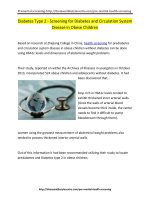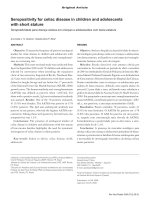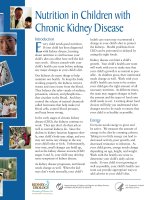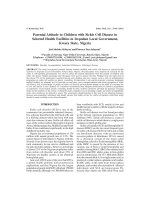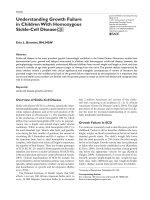Liver disease in children - Dr. Ahmed Al-Sarkhy, MD, MHSc, FAAP, FRCPC potx
Bạn đang xem bản rút gọn của tài liệu. Xem và tải ngay bản đầy đủ của tài liệu tại đây (1.13 MB, 45 trang )
Liver disease in children
Dr. Ahmed Al-Sarkhy, MD, MHSc, FAAP, FRCPC
Pediatric gastroenterology & hepatology
consultant
College of medicine & KKUH
Liver anatomy
Liver Histology
Liver has 2-Blood supply resources ; 70% from portal vein and 30%
from Hepatic artery
Liver functions
Liver enzymes # LFT
• Synthetic function
markers:
- Glucose
- Bilirubin
- Bile acids
- Albumin
- Clotting factors (PT &
PTT)
• Enzymatic markers:
- ALT
- AST
- ALP
- GGT
• The laboratory findings of liver injury can be divided broadly
into two patterns:
1) Cholestatic or obstructive bile duct injury
:
GGT & ALP > AST/ALT
2) Hepatocellular or liver cell injury:
ALT/AST > GGT/ALP.
• There is often considerable overlap between injury types in a
patient who has liver disease.
Bilirubin metabolism
QUESTIONS
Liver disease in children
• Age dependant
- Infants: Biliary atresia (BA), Neonatal hepatitis
- Older children: wilson disease, Viral hepatitis, Auto-immune
hepatitis
• Early diagnosis = better prognosis
• The main presenting symptoms of liver disease is jaundice
• Any jaundice after 2 weeks of age is pathological
Types of liver diseases
• Liver disease can be:
1- Primary cholestatic/obstructive or
2- Hepato-cellular dominant picture
3- Mixed picture-usually
Cholestatic liver disease
• Cholestasis is the obstruction of bile flow (mechanical or
functional block)
• It is characterized by an accumulation of compounds that
cannot be excreted through the bile (bile pigments, enzymes,
bile salts, cholestrol)
• Increase their levels in the serum (conjugated bilirubin, GGT &
ALP). ALT & AST increase for lesser extent
Presentation of cholestasis
• Jaundice (accumulation of conjugated bilirubin)
• Pale stool (Acholic stool)??
• Dark and foamy urine (bile salts in the urine)
• Pruritis (accumulation of bile salts)
• Xanthomas depositions (accumulation of cholestrol)
• Hepatomegaly +/- Splenomegaly
• Failure to thrive (FTT)- neonates
• Incidental lab finding
Signs of cholestatic liver disease
Hepato-cellular disease
• Necrosis of hepatocytes following a viral, ischemic or toxic
insult to the liver will cause primarily an elevation of enzymes
found within the hepatocyte (ALT and AST).
• In hepatocellular disease, the serum levels of GGT and AP do
not rise to the same degree as the aminotransferases.
Causes of liver disease in neonates
& infants
Causes of liver disease in neonates
& infants
QUESTIONS
Biliary Atresia (BA)
• Biliary atresia is an obstruction disease of the biliary tree
(mainly extra-hepatic) secondary to idiopathic inflammatory
process fibrosis and obliteration of the biliary tract
biliary cirrhosis infant death within 2 years If not
treated.
• Presentation: It presents with signs of cholestasis (jaundice,
acholic stool, pruritis, FTT) in the first 2-6 weeks of life.
• The most frequent indication for liver transplantation among
infants and children.
BA - Diagnosis
• Abdominal US: rule out the presence of a choledochal cyst
• Hepato-biliary scintigraphy (HIDA scan):
show good uptake of tracer and no excretion of it into the
intestine, even 24 hours later.
• A liver biopsy confirms the diagnosis by revealing proliferation
of the interlobular bile ducts, periportal fibrosis, and bile
plugs in canaliculi and ductules.
Hepato-biliary scintigraphy (HIDA scan)
BA
NORMAL HIDA SCAN
BA Management
• Surgical correction (Kasai portoenterostomy) :
• Should be done before 2 months (after that increase risk of
fibrosis & subsequent cirrhosis)
• Liver transplantation if failed Kasai or late presentation (> 3
months) or picture of decompensated liver disease
Choledocal cyst
• Cystic dilatation of the biliary tree at different levels
• Present with cholestasis picture, abdominal mass or
asymptomatic, biliary carcinoma
• Treatment: surgical excision
Alpha-1 Antitrypsin deficiency
• A-1 AT is a protease inhibitor (elastase, trypsin) that protect lung from
neutrophil elastase destruction
• AR
• Abnormal mutation (Pi MM Pi ZZ abnormal A-1 AT enzyme (protein)
failed excretion from liver (trapped) cholestatic liver disease
• Lung disease is very rare in children
• Dx: A-1 AT level & phenotyping
• Treatment: supportive
• Prognosis: varies (improve over time, CLD)
Neonatal Hepatitis
• “Idiopathic" neonatal hepatitis = an aetiology has not been
identified
• The list get smaller overtime (new advancement in diagnostic
modalities)
• Important to R/O obstructive disease like BA(time is crucial)
• Management of these infants involves supportive measures
till specific cause found
Evaluation of infants with cholestatic liver
disease
